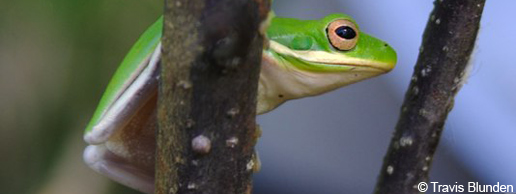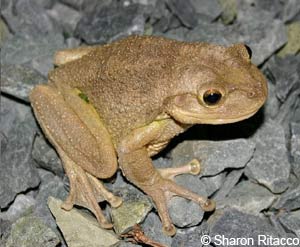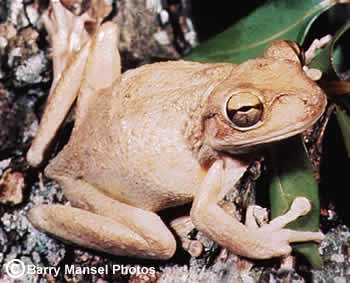
Cuban Treefrog
Osteopilus septentrionalis


Distribution/Size: The largest treefrog in North America is the Cuban treefrog (1.5 to 5 inches in body length), however it is not native to North America. This species was introduced to southern Florida from the Caribbean and has continued to spread in Florida. Cuban treefrogs have been documented as far north as Cedar Key on the Gulf Coast, Jacksonville on the Atlantic Coast, and the Orlando area in mid-Florida, and they are expanding their range.
Description: Many people have reported that after they first noticed a Cuban treefrog in their yard, they noticed the gradual disappearance of the other frogs, toads and even lizards. That's because Cuban treefrogs are voracious eaters -- and unfortunately they eat Florida's native frogs, toads, and lizards, in addition to insects and spiders. In fact, Cuban treefrogs are SO successful at taking over habitat and eating Florida's native species that they are considered an invasive exotic (non-native) species -- they are a threat to the biodiversity of Florida's native ecosystems and wildlife. You can help. See "What You Can Do for Florida" below.
The distinguishing characteristics of the Cuban treefrog are:
- Size of the adults (up to 5 inches in body length, much larger than native Florida treefrogs);
- Enormous toe pads (larger than toepads of native treefrogs in Florida);
- Bumpy skin on the back, like skin of a toad; and
- Skin on top of head is fused to skull (see test described below).
Cuban treefrogs can be highly variable in color -- from pale tan/pale green without any markings to dark green or brown with an even darker color pattern on the back and legs. Sometimes they almost look white when they are inactive or cold.
For additional photos and identifying tips, please visit Dr. Steve Johnson's Cuban Treefrog site.
Similar Treefrog Species: Squirrel treefrogs and Green treefrogs. Both of these species are native to Florida.
Habitat: This species prefers habitat that is moist and shady -- in trees, shrubs or around houses. It is commonly found near ornamental fish ponds and well-lit patios.
Reproduction: The breeding season lasts from May to October. The voice, or call, of the Cuban treefrog is variably pitched, slightly rasping or like grating stone. Male frogs call in hopes of attracting a female. Cuban treefrogs will lay eggs in any body of standing water -- from a small bucket to a fish pond, even in a chlorinated swimming pool.
Call: If you are bothered by the calling of frogs during breeding season, first buy ear plugs. Then turn out all outdoor lights around your house. Lights attract insects, and insects attract frogs. If the frogs don't move elsewhere after several nights, then try erecting a light as far as possible from your house -- hopefully the frogs will go over to that light to feed on insects, etc. There is no frog repellant or chemical to use to keep them away from your house. If the above methods don't work, buy better ear plugs and run a fan in your bedroom to create "white noise" to help drown out the calling of frogs.
Click HERE to listen to the call of the Cuban Treefrog.
(A new browser window will open with the sound file)
Click HERE to read "The Cuban Treefrog (Osteopilus septentrionalis) in Florida".
What You Can Do for Florida
Due to the destructive effects Cuban treefrogs have on native species of amphibians and reptiles, many biologists recommend that Cuban treefrogs be euthanized/killed. That's harsh, but true. We recommend a humane method of euthanasia for amphibians. Just make SURE the frog you have is a Cuban treefrog before euthanizing it (see the test suggested below).
A humane method for euthanizing amphibians:
To euthanize a Cuban Treefrog, hold the frog firmly in your hand and apply a 1 inch bead of benzocaine ointment along the back of the frog. Benzocaine ointment is a topical anesthetic (a numbing agent) used to treat skin pain (e.g., from sunburn) and itching as well as toothaches and sore throats. There are a variety of name brand and generic versions that are available over-the-counter in a tube or spray. If you are able to, using a gloved finger spread the ointment out on the frog's back. Alternatively, you could use a benzocaine spray. Once the ointment or spray is applied, place the frog in a plastic grocery bag or a sealable sandwich bag for 15-20 minutes so that the benzocaine has a chance to render the frog unconscious (be sure to seal the bag or tie it closed). After the bezocaine has anesthetized the frog, place the bag in a freezer overnight to ensure that the frog is dead and then throw it out in your trash. If you are unable to apply benzocaine to the frog, you can simply put it in a plastic bag, seal or tie the bag shut, then place it in the freezer overnight--dispose of the bag and the frog in the trash the next day. Do not throw a bagged frog into the trash without euthanizing it first. Remember, Cuban Treefrogs have a noxious skin secretion so be sure to wash your hands thoroughly after you handle the frog, even if you wear gloves or use a plastic bag.
Freezing is a humane way to kill amphibians because their bodies go into a state of torpor (metabolism slows way down) -- just as they do in cold weather outside. If the cold weather is short in duration, the frogs will come out of their torpor state. However, after an extended time in freezing temperatures, the frogs die.
A good test to determine if a frog is a Cuban treefrog is to grasp the frog firmly, but gently, and try to move the skin around on the top of the frog's head with your fingertip. The skin on the head of a Cuban treefrog is fused to the top of the skull and won't move.
Be sure to wash your hands after handling any frog or toad. They all secrete a slimy film to protect their skin, but the secretions of some species, like the Cuban treefrog, can irritate the skin and eyes of some people.
If you live north of Gainesville, FL and you think you have Cuban treefrogs in your yard, send a description or digital photo of the frog(s) via email to extension@wec.ufl.edu. We are assisting a herpetologist from the U.S. Geological Survey with mapping the distribution of this species as it expands its range.
Cuban treefrogs can change color. The one in photo below is tan with a faint darker pattern on back and legs.
In photo below, you can see the pattern on the back and legs very clearly, and the base (overall) color is a greenish brown.
At times, Cuban treefrogs appear to be almost white (photo below). Note the bumpy skin texture on the back.
For more information, please read: "The Cuban Treefrog (Osteopilus septentrionalis) in Florida."
Development of these pages was a cooperative effort. Photos were supplied by Barry Mansell Photos and calls were provided by Paul Moler, state herpetologist for the Florida Fish and Wildlife Conservation Commission.


 Location: http://yourdomain.edu
Location: http://yourdomain.edu